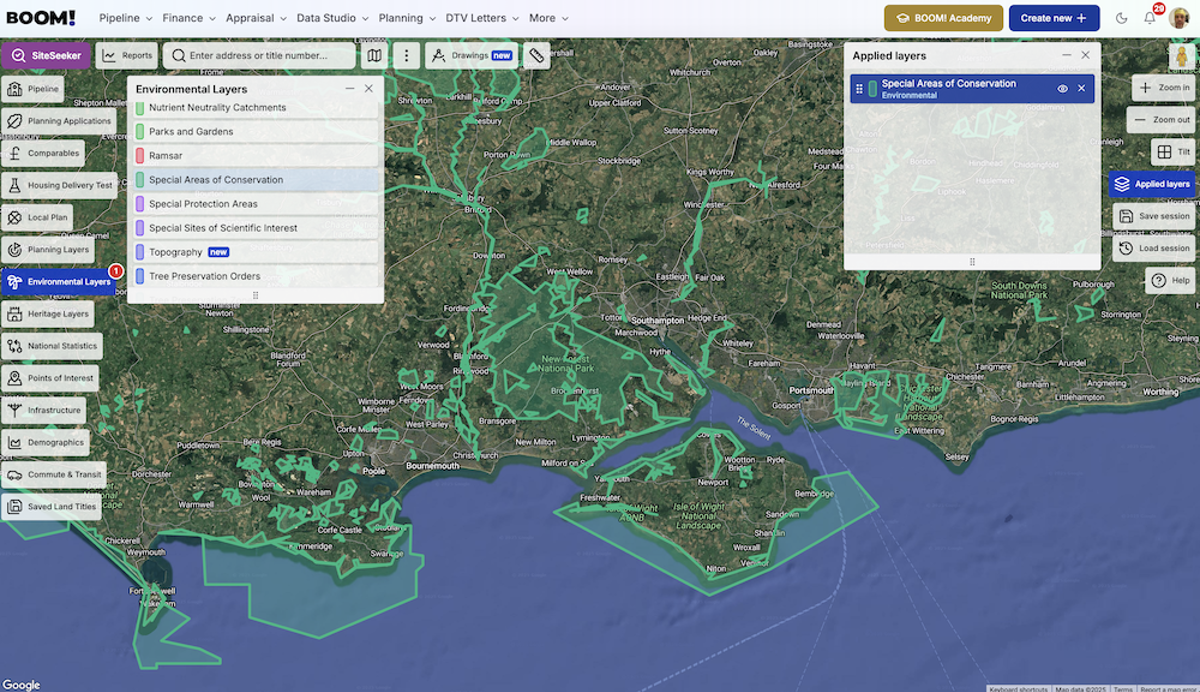How to Avoid the Special Area of Conservation Trap When Sourcing Sites (2025 Guide)







You spot a cheap, promising plot of land. It feels like your golden ticket – until you discover it’s in a “Special Area of Conservation.” Suddenly, your dream project is at risk of getting stuck or shut down. If you’ve never heard of Special Areas of Conservation (SACs), you’re not alone. Many new developers only learn about this hidden trap after they’ve invested time and money. The UK has over 600 of these protected sites scattered across the country, each guarding rare wildlife habitats with the full force of the law. In this guide, we’ll pull back the curtain on what SACs are, why they’re silent deal-killers in property development, and how you can outsmart them to keep your projects on track. By the end, you’ll know exactly how to spot and avoid this pitfall – giving you an edge over less-savvy competitors.
What Is a Special Area of Conservation (SAC)?
Think of a Special Area of Conservation as a wildlife sanctuary with a fancy name. It’s land (or sometimes water) officially designated to protect the most vulnerable habitats and species in the UK. These areas were originally part of a Europe-wide conservation network (Natura 2000), and Britain still upholds them today. In plain English: an SAC is a place so ecologically important that damaging it is essentially off-limits.
SACs aren’t just forests – they can be wetlands, heaths, moors, coastlines, you name it. (You may have heard of ancient woodlands being protected; think of SACs as a similar concept, but covering all sorts of rare habitats, not just trees.) SACs often cover large or multiple areas and can even stretch out to sea. That means the boundaries aren’t always obvious just by looking at a site. A field that looks ordinary might quietly fall under an SAC if it harbors a rare habitat or connects to a protected zone.
Importantly, UK law gives SACs the highest level of protection in planning decisions – even stricter than Sites of Special Scientific Interest (SSSIs). Local councils must consider the impact on an SAC when a planning application is nearby. In fact, under the Habitat Regulations, authorities are required to refuse or heavily condition any project that could harm an SAC’s special features. In short, an SAC isn’t just a line on a map – it’s a red line for development.
Why SACs Can Make or Break Your Development
For property developers and land sourcers, Special Areas of Conservation can be silent deal-breakers. Here’s why they matter so much to your project:
Strict legal hurdles: If your proposed site is on or even near an SAC, the planning authority is legally obligated to carry out a rigorous Habitats Regulations Assessment to scrutinize your plans. This isn’t a box-ticking exercise – it’s an in-depth environmental check against the site’s conservation objectives. Unless that assessment shows your project is completely harmless to the protected area, officials have very little freedom to approve it. In other words, even a hint of risk to an SAC can tie your project up in red tape.
Delays and uncertainty: When an SAC is involved, everything slows down. Decisions become slow, controversial, and hard to predict. You might face additional studies, public objections, and months of back-and-forth. This isn’t just theory – it’s what happens on the ground. Few things are more frustrating (or costly) than a promising deal stuck in limbo because of an environmental roadblock.
Natural England oversight: You won’t just be dealing with the local council. Natural England, the government’s conservation authority, will be watching closely. They can object to your planning application outright if they feel you haven’t fully protected the SAC’s wildlife. An objection from Natural England is a big deal – planners rarely ignore their advice. It can force you to redesign your project, add expensive mitigations, or it can stop the development entirely.
Hefty consequences for damage: This isn’t just about getting permission. If you damage a protected site, you could face severe penalties. For example, disturbing a protected SSSI (a national designation often overlapping with SACs) can lead to fines up to £20,000 in a Magistrates’ Court – or even unlimited fines for serious cases. Imagine the financial hit (and reputational damage) if you accidentally fell foul of these rules. In practice, SACs carry at least this level of seriousness, if not more. You do not want to be the developer who bulldozes a rare habitat and ends up in legal hot water.
Even nearby sites are affected: Think you’re safe because your plot borders a protected area but isn’t inside it? Think again. Buffer zones often apply. For instance, new housing within 6.2 km of Epping Forest (a famed SAC near London) now incurs special fees per home to offset the impact of extra visitors. In plain terms: even building near a Special Area of Conservation can trigger extra costs, mandatory contributions, or strict conditions. Your project might need to fund habitat improvements or create alternative green spaces just to get approval. This is the authorities’ way of saying, “Hands off the precious stuff – or pay to protect it.”
Bottom line: An SAC can turn a straightforward development into an uphill battle. It can make planning permission painfully hard to get, add surprise costs, or even render a site undevelopable. Knowing about these zones before you invest is absolutely crucial. It’s far better to walk away from a doomed site (or plan a workaround) than to charge in blind and lose big. As the saying goes in property: “Buy in haste, repent at leisure” – SACs are exactly the kind of hidden hazard that cause those regrets.
How to Spot and Avoid SAC Pitfalls (Action Steps)

The good news is you can avoid the Special Area of Conservation trap with a bit of savvy due diligence. Seasoned land sourcers use data and foresight to steer clear of these problems. Follow these steps to stay ahead:
Leverage BOOM!: Why do everything manually if technology can help? Modern property development platforms (the kind savvy deal-finders use) integrate environmental data – highlighting SSSIs, SACs, green belt land, and more all in one place. These tools will flag a red alert on a site that falls within a protected area, so you don’t waste time. Using such a platform gives you inside information at a glance, allowing you to filter out non-starters. In a competitive market, this speed is gold. While others are doing weeks of research only to uncover a fatal flaw, you’ll have moved on to the next (better) opportunity.
Consult an expert early: If a site does show some environmental sensitivity (maybe it’s near an SAC but not clearly inside one), get professional advice before you proceed. A quick chat with an ecological consultant or a planning consultant can illuminate your real options. They might tell you the project would need extensive (and expensive) ecological surveys, or they might suggest tweaks to avoid impacts. Yes, it’s an extra step, but it’s far cheaper than a failed planning application. Think of it as insurance – a few hundred pounds on an expert opinion can save you tens of thousands down the line.
Plan for mitigation (or walk away): If you decide to go forward with a site near a protected area, be prepared to go the extra mile in protecting nature. This could mean designing your site layout to leave a buffer, timing construction to avoid disturbing wildlife, or agreeing to create new habitat elsewhere as compensation. Factor these into your budget and timeline. However, also be ready to walk away if the constraints are too severe. Not every plot is worth the hassle. There are cases where only projects of “overriding public interest” (think highways, hospitals, not a small housing estate) are allowed to infringe on an SAC. If your development doesn’t fit that bill, trying to force it can be a losing battle. It takes wisdom (and sometimes courage) to cut your losses and find a more suitable site.
Key Takeaways: Stay Savvy, Stay Successful
Special Areas of Conservation might sound like obscure jargon, but for a property developer they can spell disaster if ignored. The key takeaway is simple: due diligence isn’t optional. By making environmental checks a routine part of your site sourcing, you protect yourself from nasty surprises.
Remember, knowledge is power in this game. Now that you know what SACs are and how they operate, you won’t be caught off guard. Instead of walking into a legal buzzsaw, you’ll spot the warning signs on day one. This means you can confidently pursue deals that others might foolishly pass over or ruin by accident.
In a field where beginners often slip up, you’ve just armed yourself with insider knowledge. You’re not just learning trivia – you’re learning how to save your project and your profits. So the next time you evaluate a promising plot, do what the pros do: check for that SAC designation (and other constraints) right away. It’s a quick step that can make the difference between a smooth win and a costly mistake.
By staying alert to Special Areas of Conservation, you’ll move faster, act smarter, and build with peace of mind. No more hidden traps – just solid, informed decisions. That’s how you develop property the right way in 2025 and beyond.
To better understand how you can leverage Special Areas of Conservation sign up for a 7 day FREE trial or book a call with us and let us show you.